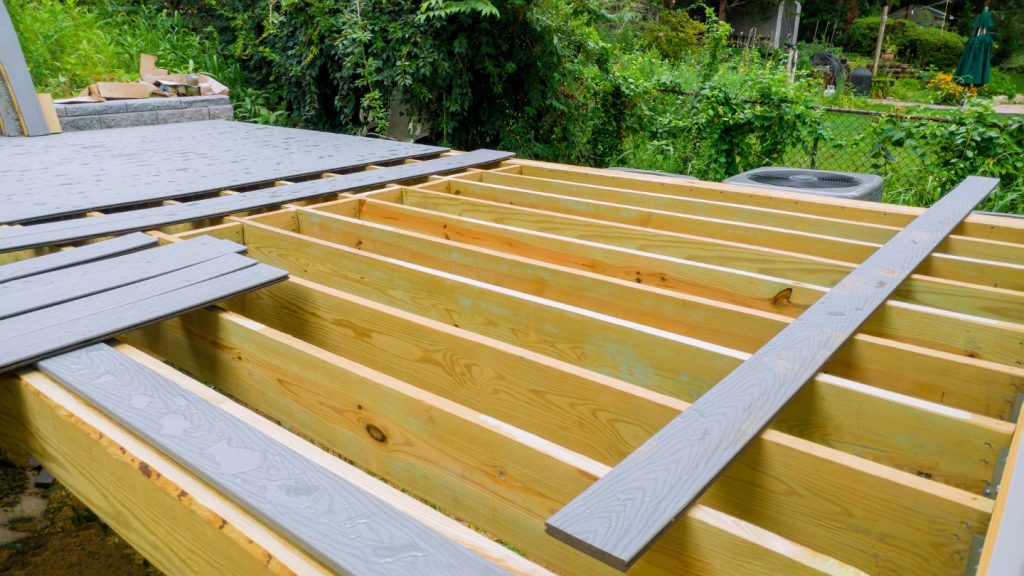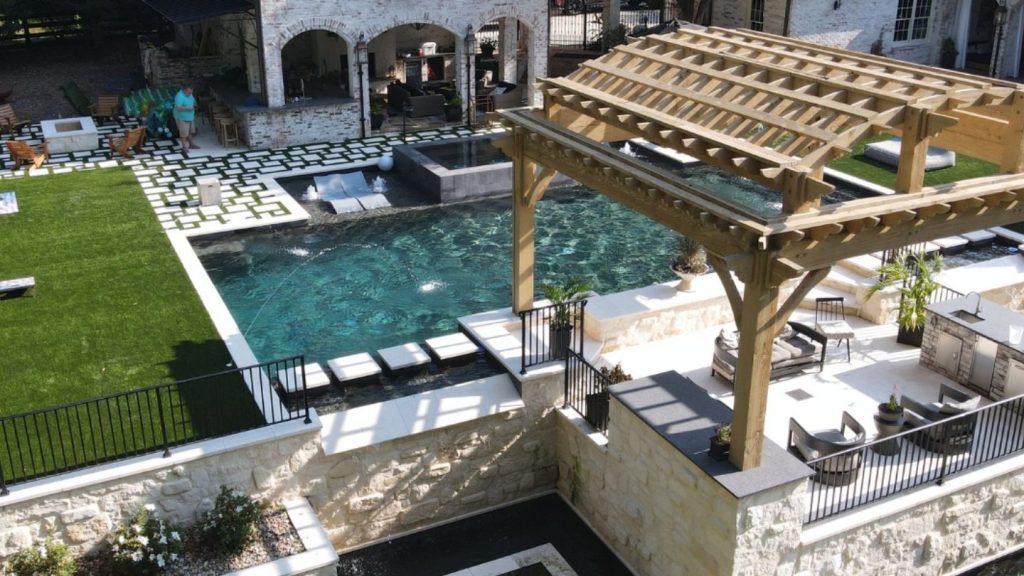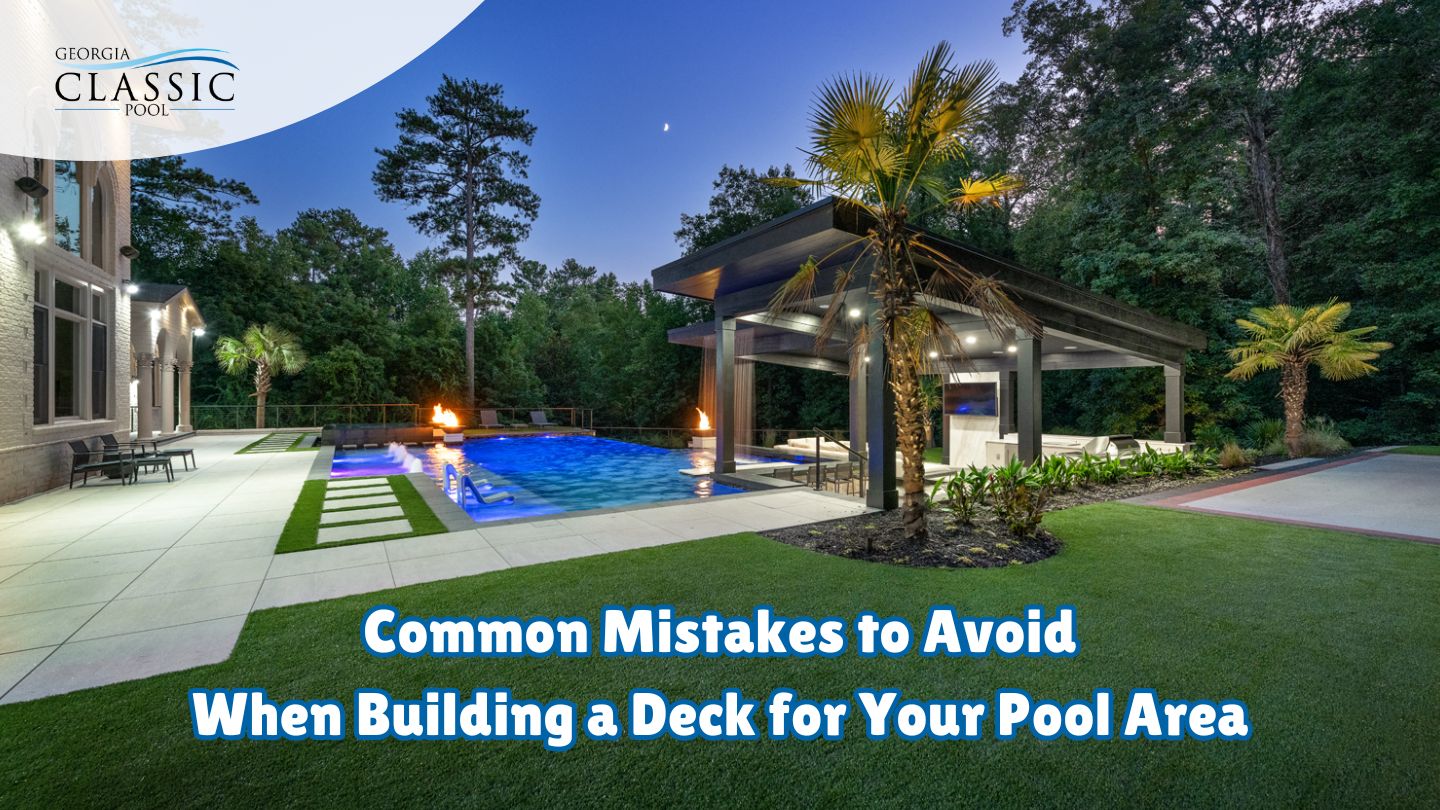Building a deck for your pool or outdoor living space is an exciting project that enhances both your home’s value and your family’s enjoyment. However, there are common issues that can arise during the deck construction process, potentially leading to safety concerns, added costs, or the need for repairs down the line. The good news is that with the right knowledge and professional guidance, these issues can be easily avoided.
In this blog, we’ll discuss the most common challenges in deck building and offer expert advice to ensure your deck is both safe and durable. Whether you’re creating a poolside deck or an integrated outdoor living space, the right professional deck services can help you create a dream deck that complements your outdoor space.
1. Improper Ledger Board Attachment

The ledger board is a key structural element that connects your deck to the house. Ensure your plan complies with local deck building codes and regulations. If the ledger board is not attached properly, it can lead to significant safety risks, including the potential for a deck collapse.
How to Ensure a Secure Ledger Board
To guarantee a secure attachment, use bolts or special hold-down anchors to attach the ledger board to the house. These fasteners are much stronger than nails, which can weaken over time. Professionals will make sure the ledger board is aligned correctly with the house’s rim joist and securely fastened with stainless steel or zinc-coated steel fasteners to prevent corrosion, particularly around pools and spas.
By working with a professional deck builder, you ensure the ledger board is properly installed, maintaining the deck’s structural integrity and safety.
2. Inadequate Footing Size
Footings are the foundation of your deck and must be sized correctly to support the entire structure. Proper deck footing is essential to prevent the deck from shifting or sagging over time, especially in pool areas where the ground may experience moisture fluctuations.
How to Ensure Proper Footing Size
Make sure that deck footers extend below the local frost line to prevent shifting during freeze-thaw cycles. Professional deck builders understand the necessary footing depth for your region and can ensure they meet the specific requirements for the climate and soil, including the proper dimensions for a deck post footer to distribute loads effectively. Additionally, reinforcing the footings with steel reinforcement ensures added stability.
By hiring a professional, you can rest assured that the footings are designed and installed to meet local building codes, ensuring the deck remains stable for years.
3. Incorrect Deck Joist Spacing

Joist spacing plays an essential role in ensuring the stability and strength of your deck. Proper installation of deck joists is crucial to prevent a deck surface from sagging or becoming unstable, especially in high-moisture areas like poolside decks.
How to Ensure Proper Joist Spacing
For composite decking, joists should typically be spaced 12 inches apart, while for wooden decks, 16 inches in the center is standard. However, composite materials may require tighter spacing, especially when installed in diagonal patterns.
A professional deck builder will follow the manufacturer’s installation instructions and ensure the joists are spaced correctly, preventing sagging and maintaining the deck’s overall structural integrity.
4. Choosing the Wrong Decking Material
Choosing the wrong decking material can lead to more frequent repairs, increased maintenance costs, and a deck that doesn’t stand up well to the elements, particularly around pools where moisture exposure is higher.
How to Choose the Right Decking Material
Composite decks are an excellent choice for poolside areas because they resist moisture, fading, and warping. Composite decking also has low maintenance and a long lifespan. If you prefer the look of wood, opt for treated lumber designed for outdoor use, which can withstand the elements more effectively than untreated wood.
Professional deck builders can help you choose the best decking materials based on your climate and the aesthetic you want to achieve, ensuring a durable and attractive outdoor space.
5. Not Protecting Treated Lumber
While treated lumber is durable, it’s still susceptible to moisture-related damage, especially in humid environments or around pools.
How to Protect Treated Lumber
To protect the lumber from moisture damage, apply joist tape or rubberized synthetic membranes. These materials create a barrier that prevents moisture from seeping into the wood, helping to preserve the deck’s undercarriage and treated lumber deck post.
Additionally, opting for composite decking materials can reduce the need for frequent maintenance and provide even more protection from moisture.
6. Ignoring Local Building Codes

Failing to comply with local building codes can lead to structural instability, safety concerns, and potential legal consequences. Building codes are in place to ensure that decks are safe and constructed correctly.
How to Ensure Compliance with Building Codes
Professional deck builders are familiar with local building codes and can ensure that your deck meets all the required safety standards. They will handle all necessary permits and inspections, making sure that your deck is built to code from start to finish.
By working with an experienced professional, you can avoid any compliance issues and ensure the safety and legality of your deck construction.
7. Poor Handrail Installation
Handrails are a crucial safety feature for elevated decks, particularly around pools and spas. Incorrect handrail installation can lead to safety hazards, including the risk of falls.
How to Ensure Proper Handrail Installation
Handrails should be installed at a height of at least 36 inches and should be able to withstand at least 200 pounds of force. Through bolts should be used to securely fasten the handrails to the deck. The spacing between balusters should also be no greater than 4 inches to prevent children from slipping through.
A professional deck builder will ensure the handrails are installed correctly and meet all safety standards, providing peace of mind for you and your family.
8. Skipping Deck Flashing
Deck flashing is essential for protecting your home’s structure from water damage. Without proper flashing, water can seep between the deck and the house, causing rot and other damage.
How to Install Deck Flashing Correctly
Metal flashings, such as zinc-coated steel or copper, should be installed at the junction between the deck and the house. These materials provide a long-lasting, water-resistant barrier. Kick-out tabs should be included to direct water away from the house’s foundation.
A professional deck builder ensures that flashing is installed properly, safeguarding both your deck and home from water damage.
9. Obstructing Access to the Deck
Blocked pathways or deck stairs can make it difficult to enter or exit the deck safely, creating safety hazards, particularly in an emergency.
How to Ensure Clear Access to the Deck
Make sure deck stairs and pathways are kept clear of obstacles to provide safe and easy access to and from the deck. Deck builders design decks with smooth traffic flow in mind, ensuring unobstructed access points for safety and convenience.
A well-designed deck will have easy-to-navigate entry points, ensuring that everyone can enjoy the deck with minimal risk.
10. Failing to Install Proper Railings and Safety Features
Railings are one of the most important safety features of any deck, especially for elevated decks or those near pools. Inadequate railings or the absence of safety features can increase the risk of falls or other accidents.
How to Ensure Proper Railings and Safety Features
Ensure that deck railings meet local building codes, typically requiring a minimum height of 36 inches. The spacing between balusters should not exceed 4 inches. Guardrails should be securely fastened and capable of withstanding at least 200 pounds of pressure.
A professional deck builder will ensure that railings and safety features are properly installed, giving you peace of mind while enjoying your outdoor space.
How to Maintain and Inspect Your Deck Regularly
Regular inspections and maintenance are crucial to ensure the longevity and safety of your deck. Neglecting these tasks can lead to costly repairs, safety hazards, and even deck collapse. Here’s how to maintain and inspect your deck regularly:
- Inspect Annually: Conduct a thorough inspection of your deck at least once a year. Look for signs of wear, damage, and rot, particularly in high-moisture areas like around pools.
- Clean Regularly: Keep your deck clean by sweeping away debris and washing it periodically. This helps prevent mold and mildew buildup, which can damage deck boards and compromise structural integrity.
- Check for loose boards: Inspect your deck boards for any loose or damaged ones. Replace or repair them promptly to prevent accidents and maintain a smooth surface.
- Inspect Railings and Guardrails: Ensure that all railings and guardrails are secure and meet local building codes. Loose or unstable railings can pose significant safety risks.
- Monitor for Pests: Look for signs of pest or rodent infestation, such as chewed wood or nests. Address any issues promptly to prevent further damage.
- Maintain Structural Integrity: Regularly check the structural components of your deck, including support posts, joists, and footings. Look for signs of rot, rust, or other damage and address them immediately.
- Keep Your Deck Dry: Ensure your deck is properly sealed and protected from the elements. Apply a high-quality sealant to prevent water damage and extend the life of your deck.
- Consider Professional Help: If you’re unsure about inspecting or maintaining your deck, consider hiring a professional deck builder or inspector. They can provide expert advice and ensure your deck remains safe and durable.
By following these steps, you can ensure your deck remains safe, durable, and enjoyable for years to come. Regular maintenance not only extends the life of your deck but also helps you avoid costly repairs and potential safety hazards.
Final Thoughts on Building a Deck
Building a deck offers a rewarding way to enhance your outdoor living space, but it’s essential to steer clear of common mistakes that could affect its durability and safety. By prioritizing thorough planning, choosing high-quality materials, and focusing on meticulous details, you can create a deck that stands the test of time and becomes a cherished part of your home.
At Georgia Classic Pool, we extend our expertise beyond pools to include a variety of outdoor projects, ensuring that your backyard vision becomes a reality. If you’re ready to elevate your outdoor environment with a beautiful deck or are searching for professional swimming pool installation services in Atlanta and around, reach out to us today. Transform your outdoor space into your personal paradise with our expert services.


